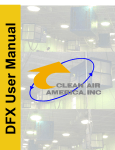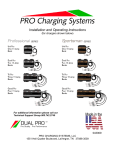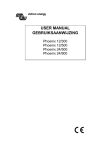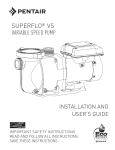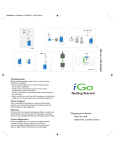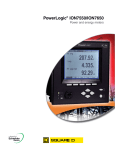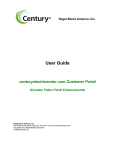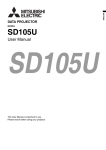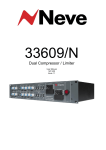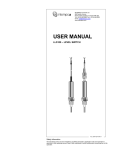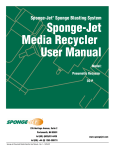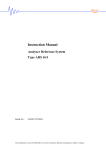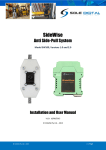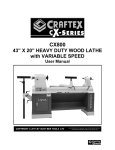Download VARIABLE SPEED USER MANUAL
Transcript
v VARIABLE SPEED USER MANUAL Premium Efficiency Variable Speed Motor v SAFETY Safety is emphasized throughout the user manual. These are safety alert symbols. They alert the user to potential personal injury hazards. Obey all safety messages to avoid possible injury or death or damage to equipment. DANGER DANGER DANGER indicates a hazardous situation which, if not avoided, will result in death or serious injury. CAUTION CAUTION identifies potential equipment damage or failure conditions. Also, alerts personnel to potentially dangerous situations. WARNING WARNING indicates a hazardous situation which if not avoided could result in death or serious injury. 1 v Table of Contents 1. 2. 3. 4. 5. 6. 7. 8. 9. 10. Introduction............................................................................... 3 User Interface............................................................................ 5 2.1 Quick Start Guide (Using Factory Schedule)................................. 5 2.2 Quick Start Guide (Using Custom Schedule)................................. 6 Overview.................................................................................... 7 Wiring......................................................................................... 8 User Interface Operation........................................................ 10 5.1 Navigation Overview............................................................. 10 5.2 Menu Structure for 8 Selector Knob Positions..............................11 5.3 Set the Clock....................................................................... 12 5.4 Set the Schedule.................................................................. 13 5.4.1 Schedule Tables.......................................................... 14 5.5 Service.............................................................................. 17 5.6 Setup................................................................................ 18 5.6.1 Freeze Protection....................................................... 19 5.6.2 Auxiliary Load Setup............................................................. 20 5.6.3 Prime Configuration.............................................................. 22 5.6.4 Reset Factory Defaults.......................................................... 23 5.6.5 Set Contrast........................................................................ 23 5.7 Run Schedule...................................................................... 24 5.8 Override Low....................................................................... 25 5.9 Override High...................................................................... 27 5.10 Key Lockout Feature............................................................. 29 Care and Maintenance............................................................ 29 Remote Mounting User Interface.......................................... 29 Fault Tables............................................................................. 34 Specifications......................................................................... 35 Troubleshooting Guide.......................................................... 36 2 v 1 Introduction The V-Green is a premium efficiency variable speed motor that provides tremendous flexibility in motor speed and time settings. The variable speed V-Green motor is intended to run on the lowest speeds needed to maintain a sanitary environment, which, in turn, minimizes energy consumption. Conditions such as pool size, other water features, chemicals used, and environmental factors help determine how to optimize the motor settings to maximize energy conservation. The integrated electronics interface controls the power supply to the motor, speed settings between 600 and 3450 rpm, and the start and stop times. The motor can run at speeds between 600 and 3450 rpm. The motor is rated for 230Vrms (+10% or -7%) at an input frequency of 60 Hz. 3 v Features • Innovative user interface with step-by-step on-screen navigation and ergonomic selector switch • Power factor correction • Auxiliary load circuit with configurable run time • Motor design reduces noise emissions • Real time clock with 5 year battery back-up to protect programming • Integrated LCD backlight and adjustable contrast • UV and rain-proof enclosure • Adjustable freeze protection • Manual High and Low overrides Benefits • Set-up and programming ease – preset program • Ease of installation, with no additional wiring required • Display can be mounted on or off board, facing the pump or facing the lead-end • Lower power consumption • Design reliability • Lower internal peak currents; Input current reduced from 16A to 10A • Ability to install and program extra load (i.e., salt chlorine generator, booster pump, etc.) • No need to replace battery or reset time/settings during a power outage or off-season • Ensures the display can be viewed easily in dark, shady, or direct sunlight conditions 4 v 2 User Interface 2.1 Quick Start Guide (Using factory schedule) The V-GreenTM is programmed with a pre-set schedule that complies with California Title 20 requirements. Only the clock setting is required to enable the V-Green to operate at three different speeds and durations using the pre-set schedule. The preset speeds and schedule times are detailed in Table 4. q Observe all safety warnings and cautions q Verify the user interface is plugged in q Make certain the motor is properly wired (refer to Figure 1) q Turn selector knob to SET CLOCK q Set the Time and Date using the +, -, ←, → buttons q Turn the Selector knob to RUN NOTE: Must wait until “PRIME MODE” is complete to make changes to OVERRIDE settings. 5 v 2.2 Quick Start Guide (Using custom schedule) q Observe all safety warnings and cautions q Verify the user interface is plugged in to the controller q Make certain the motor is properly wired (refer to Figure 1) q The green Power On LED illuminates when the unit is powered on q The red Fault LED illuminates when a fault occurs q Use the ← and → arrow buttons to select menu areas q Use the + and – to change menu selection parameters q Turn selector knob to SET CLOCK q Adjust the Time and Date q Turn selector knob to Set Schedule (STEP 1, 2, 3) q Set the Motor Speed, Start, and Stop times for steps 1, 2, 3 q Turn selector knob to SETUP (Use ← and → to scroll thru SETUP items) qEnable/disable freeze protection qSet display screen contrast qSet External Relay Speed and Time qSet Prime speed and duration qReset Factory defaults (Will return settings to factory defaults) q Turn selector knob to RUN q Press OVERRIDE HIGH button (not required to run normal schedule) q Press SET to change Override High speed and duration (not required to run normal schedule) q Press OVERRIDE LOW button (not required to run normal schedule) q Press SET to change Override Low speed and duration (not required to run normal schedule) 6 v 3 Overview The V-Green motor can be optimized to suit individual pool conditions. Specific conditions, including pool size, other devices, and environmental factors all help determine the optimal settings. This may require some trial and error to determine the most satisfactory settings. In all cases, setting the V-Green motor at the lowest speed for the longest duration is the best choice to minimize energy consumption. However, filtration needs may dictate running the VGreen motor at a higher speed for some duration of time each day to maintain proper sanitation. The User Interface is located on top of the motor controller. To the left of the screen are the Power Saver (Override Low) button and the Clean (Override High) buttons. These buttons can be used to operate the motor at speeds outside of the normal operating schedule. The rotating selector knob allows the user to do the following: • Set the clock • Schedule the motor speed and timings • View the serial number, software versions, and fault codes • Enable or disable freeze protection • Configure auxiliary load • Adjust screen contrast • Reset the factory defaults • Set the prime time and speed 7 v 4 Wiring The controller must be wired according to the local NEC guidelines. A licensed, qualified electrician should complete the wiring for this product. The controller is designed to operate with 230Vrms, single phase power. The wire insulation should be stripped to a length of approximately 0.33.” The terminal block is capable of handling solid or stranded wire up to 12 AWG in size. Pin # Wire Color Description TB1 - L1 Black Hot 1 TB1 - L2 Red or White Hot 2 TB1 - GND Green Earth J108 - A1 Any Aux 1 (Normally Open) J108 - A2 Any Aux 2 (Normally Open) Table 1: Power Connection Pin # Wire Color Description J103 - 1 Red +10V J103 - 2 Green RS485 - A J103 - 3 Black RS485 - B J103 - 4 Yellow Isolated ground Table 2: Communication Connection Table L1 (BLACK) L2 (RED OR WHITE) 230V POWER SOURCE EARTH Figure 1: Wiring Diagram without Aux Load 8 v Figure 2: Wiring Diagram with 115V Aux Load L1 (BLACK) EARTH EARTH L2 (RED OR WHITE) LINE (BLACK) L2 (RED OR WHITE) 230V POWER SOURCE 230V AUXILIARY LOAD Figure 3: Wiring Diagram with 230V Aux Load 9 v 5 User Interface Operation 1. 2. 3. 4. +, - increases/decreases selected value ←, → navigates to adjustable value (digit) (SET) accepts the current screen values (BACK) returns to previous program setting and does NOT accept current screen values 5.1 Navigation Overview Figure 4: UI Overview Display Screen Navigation Buttons LED Lights Power On Light (Green) Fault Light (Red) Interface Selector Knob Override Buttons Back Button Table 3: UI Button Descriptions NOTE: The selector knob must be turned to RUN for the motor to operate. When the user presses ← or → the cursor moves to the next or previous position. If the cursor is at the end of a line when the user presses the arrow, the cursor moves to the next line. 10 v 5.2 Menu Structure for Selector Knob Positions 1. SET CLOCK a. Date and Time 2. STEP 1 (Set Schedule) a. Speed, Start Time, Stop Time 3. STEP 2 (Set Schedule) a. Speed, Start Time, Stop Time 4. STEP 3 (Set Schedule) a. Speed, Start Time, Stop Time 5. SERVICE a. UNIT SERIAL NUMBER b. DC CAP VOLTAGE c. IGBT TEMPERATURE d. PCB TEMPERATURE e. FAULT HISTORY (1,2,3,4) f. CONTROLLER SOFTWARE VERSION g. INTERFACE SOFTWARE VERSION 6. SETUP a. FREEZE PROTECTION i. Enabled/Disabled ii. Turn ON Temperature b. AUX LOAD SETUP i. Minimum Turn On Speed ii. Maximum Run Time (in 24 hours) c. PRIME CONFIGURATION i. Speed ii. Time d. RESET FACTORY DEFAULTS i. Yes/No e. SET CONTRAST 7. RUN a. Manual Override High i. Speed and Duration b. Manual Override Low i. Speed and Duration 8. OFF 11 v 5.3 Set the Clock The first time the user interface is turned ON, the clock must be set to the current time. Figure 5: SET CLOCK Menu Buttons 1. Turn the selector knob (see Figure 5) to SET CLOCK. 2. At any time, the user can press BACK to return to the previous area. 3. Press + or – to change the Month. Press → to move to the Day setting. 4. Press the + or – to change the Day. Press → to move to the Year setting. 5. Press + or – to change the Year. Press → to move to the Hour setting. 12 v 6. Press + or – to change the Hour. Press → to move to the Minute setting. 7. Press + or – to change the Minute. Press → to move to the AM or PM setting. 8. Press SET when the time is correct. 9. Press SET again if the user needs to make additional changes. The cursor returns to the Month setting. 10. If the date and time are correct, move the selector knob to Set Schedule, Step 1. NOTE: Neither of the Override buttons affects this menu. The message “Invalid Key” appears if the user presses an Override button. 5.4 Set the Schedule Set the Speed and Start/Stop times for the motor in the Set Schedule menu. The schedule is based on a 24-hour cycle and will repeat each day of the week. 13 v The highest speed rating for this motor is 3450 rpm and the lowest is 600 rpm. The following table shows the pre-set schedule. Setup #1 Step 1 Step 2 Step 3 Speed 3450 RPM 2600 RPM 1725 RPM Start Time 8:00 AM 11:00 AM 1:00 PM Stop Time 11:00 AM 1:00 PM 9:00 PM Table 4: Pre-set Schedule 5.4.1 Schedule Tables Use these tables to enter a personalized operating schedule. By writing down the planned schedule, it will make the programming process easier and will help the user to remember the user’s settings in case the programming is inadvertently lost. The User Interface will not allow the user to program an overlap between different steps of the schedule. The most recent setting will always take priority over any previous settings. Setup #2 Step 1 Step 2 Speed Start Time Stop Time 14 Step 3 v Setup #3 Step 1 Step 2 Step 3 Speed Start Time Stop Time Table 5: Custom Schedules 1. Make certain the selector knob points to Set Schedule, Step 1. Figure 6: Set STEP 1 Menu Buttons 2. The first digit in the Speed setting flashes. Press + or – to change the first digit in the Speed setting. The number increases one unit at a time. 3. Press → to move to the second digit in the Speed setting. Press + or – to change the second digit. The number increases one unit at a time. 4. Press → to move to the third digit in the Speed setting. Press + or – to change the third digit. The number increases one unit at a time. 15 v 5. Press → to move to the fourth digit in the Speed setting. Press + or – to change the fourth digit. The number increases five units at a time. 6. Press → to move to the Start Time setting. 7. Press the + or – to change the Hour. Press → to move to the Minute setting. 8. Press the + or – to change the Minute. Press → to move to the AM or PM setting. 9. Press → to move to the Stop Time setting. Follow steps 6 through 8 to set the Stop Time settings. 10. Press Set to save the settings. If necessary, press Set again to move the cursor back to the first digit. Unless changes are necessary, move the selector knob to Steps 2 and 3 and repeat procedural steps 2 through 10. Figure 7: Set STEP 2 and STEP 3 Locations Move the selector knob to Service when the settings for Steps 1, 2, and 3 are set. NOTE: Neither of the Override buttons affects this menu. The message “Invalid Key” appears if the user presses an Override button. 16 v 5.5 Service The Service menu allows the user to view, but not change, the following information. • Unit model number and serial number • User Interface Version number • Controller Software Version • The four most recent faults • PCB Temperature • IGBT Temperature • DC Cap Voltage Press the arrows to navigate between items viewed on the display screen. Figure 8: Service Menu Buttons 17 v 5.6 Setup Setup allows the user to configure the following parameters: • • • • • Freeze Protection Auxiliary Load Settings Prime Settings Reset Factory Defaults Set Contrast Level Figure 9: Setup Menu Buttons 18 v 5.6.1Freeze Protection Freeze Protection can be either enabled or disabled when the user turns the User Interface selector knob to Setup. If it is enabled, the user will be able to set the temperature at which the pump will turn on. The control is designed to run the pump for 8 hours at 2600 RPM if the temperature drops below the setpoint. 1. Make certain the selector knob points to Setup. 2. Press either + or – to change the Freeze Protection setting. Press Set to save any changes. WARNING: Freeze Protection will ONLY function with the selector knob in the RUN position. Damage may occur to the user’s pool system if Freeze Protection is enabled and the switch is not in the RUN position. 19 v 5.6.2Auxiliary Load Setup The Auxiliary Load is a relay inside the control designed to provide AC power to a load that should not be energized without adequate water flow from the pump (i.e. heater, boost pump, salt water chlorinator). The control is designed to turn on the Auxiliary Load relay when the pump speed is above the MINIMUM ON SPEED (default is 2000RPM). The Auxiliary Load relay will stay closed as long as the pump speed is above the MINIMUM ON SPEED. In addition, the control can be programmed to limit the amount of time the Auxiliary Load relay is closed in a 24-hour period. For example, if the pump runs at 3450RPM for 12 hours a day, but the auxiliary load only needs to be powered for 6 hours, the user can set the MAXIMUM RUN TIME. Two examples of different settings are provided in Table 6 and Table 7. 1. Make certain the selector knob points to Setup. 2. Press → one time to change the Auxiliary Load settings. Press SET to enter “change mode.” Press + or – to increase or decrease the Minimum Speed. Press → to change the Maximum Run Time. Press the + or – to increase or decrease the Maximum Run Time. Press SET to save changes. 20 v 5.6.2.1 Setup Tables (for Auxiliary Load) Example #1 Pump Motor Settings Aux. Load Settings Step 1 Step 2 Step 3 3450 RPM 2600 RPM 1725 RPM Start Time 8:00 AM 11:00 AM 1:00 PM Stop Time 11:00 AM 1:00 PM 9:00 PM Speed MIN ON SPEED 2000 RPM MAX RUN TIME 10.5 Hours Total run time for pump motor 13 Hours Total run time for aux. load 5 Hours Table 6: Auxiliary Load Setup Example #1 Example #2 Pump Motor Settings Aux. Load Settings Step 1 Step 2 Step 3 3450 RPM 2600 RPM 1725 RPM Start Time 8:00 AM 4:00 PM 8:00 PM Stop Time 4:00 PM 8:00 PM 11:00 PM Speed MIN ON SPEED 2000 RPM MAX RUN TIME 10.5 Hours Total run time for pump motor 15 Hours Total run time for aux. load 10.5 Hours Table 7: Auxiliary Load Setup Example #2 21 v 5.6.3Prime Configuration The priming speed and time can be adjusted within this menu. The minimum priming speed is 1500 RPM. The maximum priming time is 10 minutes. 1. 2. 3. 4. 5. 6. Make certain the selector knob points to Setup. Press → two times to change the Prime settings. Press SET to enter “change mode.” Press + or – to increase or decrease the Prime Speed. Press → to change the Prime Time. Press the + or – to increase or decrease the Maximum Run Time. Press SET to save changes. 22 v 5.6.4Reset Factory Defaults This menu will permit the user to reset all settings in the control to the factory default settings. 1. Make certain the selector knob points to Setup. 2. Press → three times to Reset to Factory Default settings. Press SET two times to verify intent to Reset to the Factory Default settings. 5.6.5Set Contrast This menu will change the contrast of the LCD screen to optimize viewing for various lighting conditions. 1. Make certain the selector knob points to Setup. 2. Press → four times to change the Contrast setting. Use + and – to adjust the contrast level. Press SET to save the setting. 23 v 5.7 Run Schedule The display screen in the Run switch position shows the following. • Current clock time • Remaining time • Which Step or Prime is running and at what RPM • Motor status (for example, Program Running) Figure 10: RUN Schedule Buttons Motor Run allows the user to set the Override parameters. Run the Override settings if the motor needs to perform a certain function immediately. If the user presses +, -, ←, or → the message “Speed and Time Cannot be Changed” appears. If the user presses the Back button the message “Speed and Time Cannot be Changed” appears unless an Override setting is running. 24 v 5.8 Override Low The Override Low button can program the motor to temporarily run at speeds between 600 and 3450 RPM. Override Low is recommended for low circulation requirements that exist outside of the daily operating schedule. Once the Override Low duration is completed, the motor will automatically return to the programmed schedule. NOTE: Press + to increase the speed. If the value is at 3450, the screen reads “Maximum Speed for this Motor is 3450 RPM.” If the fourth digit is flashing, press + and the speed increases by 5. 25 v If the third digit is flashing and the value of the speed is 3445 then the speed increases to 3450. If the third digit is flashing and is less than 3445, the speed increases by 10. If the second digit is flashing and greater than or equal to 3350, the speed increases to 3450. If the third digit is flashing and less than 3350, the speed increases by 100. If the first digit is greater than or equal to 2450, the speed increases to 3450. If the first digit is flashing and less than 2450, the speed increases by 1000. Hold + and the values increase rapidly. Press – to decrease the speed. If the value is at 0 RPM, the screen reads “Minimum Speed for this Motor is 0 RPM.” If the value of the high speed is 600 then it decreases to 0 RPM. If the fourth digit is flashing, press – and the speed decreases by 5. If the third digit is flashing and the value of the speed is 605, the speed decreases to 600. If the third digit is flashing and greater than 605, the speed decreases by 10. If the second digit is flashing and less than or equal to 700, the speed decreases to 600. If the second digit is flashing and greater than 700, the speed decreases by 100. If the first digit is less than or equal to 1600, the speed decreases to 600. If the first digit is flashing and greater than 1600, the speed decreases by 1000. Hold – and the values decrease rapidly. 1. Press Override Low. 2. Press SET to change the Override Low settings. 3. Press + or – to increase or decrease the first digit in the speed. The maximum speed is 3450 RPM and the minimum speed is 600 RPM. 4. Press → to move to the second, third, and fourth digits in the speed. 5. Press SET to save the speed setting. The motor runs at the Override Low setting. The Override Low Duration Time setting flashes. 6. Press + or – to increase or decrease the Override Low Duration Time. The maximum duration is 24 hours and the minimum is . 5 hours (half an hour). 7. Press SET to save the Override Low Duration Time setting. 26 v 5.9 Override High The Override High button can program the motor to temporarily run at speeds between 600 and 3450 RPM. Override High is recommended for high flow uses such as a pool heater startup, backwash, filtering, and cleaner water requirements that exist outside of the daily operating schedule. Once the Override High duration is completed, the motor will automatically return to the programmed schedule. 27 v NOTE: Press + to increase the speed. If the value is at 3450, the screen reads “Maximum Speed for this Motor is 3450 RPM.” If the fourth digit is flashing, press + and the speed increases by 5. If the third digit is flashing and the value of the speed is 3445 then the speed increases to 3450. If the third digit is flashing and is less than 3445, the speed increases by 10. If the second digit is flashing and greater than or equal to 3350, the speed increases to 3450. If the third digit is flashing and less than 3350, the speed increases by 100. If the first digit is greater than or equal to 2450, the speed increases to 3450. If the first digit is flashing and less than 2450, the speed increases by 1000. Hold + and the values increase rapidly. Press – to decrease the speed. If the value is at 0 RPM, the screen reads “Minimum Speed for this Motor is 0 RPM.” If the value of the high speed is 600 then it decreases to 0 RPM. If the fourth digit is flashing, press – and the speed decreases by 5. If the third digit is flashing and the value of the speed is 605, the + speed decreases to 600. If the third digit is flashing and greater than 605, the speed decreases by 10. If the second digit is flashing and less than or equal to 700, the speed decreases to 600. If the second digit is flashing and greater than 700, the speed decreases by 100. If the first digit is less than or equal to 1600, the speed decreases to 600. If the first digit is flashing and greater than 1600, the speed decreases by 1000. Hold – and the values decrease rapidly. 1. Press Override High. 2. Press SET to change the Override High settings. 3. Press + or – to increase or decrease the first digit in the speed. The maximum speed is 3450 RPM and the minimum speed is 600 RPM. 4. Press → to move to the second, third, and fourth digits in the speed. 5. Press SET to save the speed setting. The motor runs at the Override High setting. The Override High Duration Time setting flashes. 6. Press + or – to increase or decrease the Override High Duration Time. The maximum duration is 24 hours and the minimum is .5 hours (half an hour). 7. Press SET to save the Override High Duration Time setting. 28 v 5.10 Key Lockout Feature The A. O. Smith User Interface has a key lockout feature to prevent unwanted changes to the settings. To lock the keys, hold down the “+, -, and SET” buttons for more than 3 seconds. The display will then show a symbol of a key indicating the buttons are locked. The user can unlock the keys by holding down the same buttons for more than 3 seconds. 6 Care and Maintenance The V-GreenTM motor is very reliable and robust in harsh environments. However, this product does contain electronics that are cooled by a fan mounted to the motor. In order to ensure optimum reliability of this product, it is recommended to clean the fan inlet on the back of the motor once a month. It is important to keep this area free of large debris such as leaves, branches, mulch, plastic bags, etc. 7 Remote mounting User Interface The V-Green user interface can be mounted remotely from the controller. In order to complete this procedure, the following steps should be followed: A. Remove main power from the controller. B. Remove the terminal box cover from the controller (two screws). 29 v Figure 11: Terminal Box Cover Removed C. Remove the plastic wiring cover inside the terminal box (one screw). Figure 12: Internal Plastic Cover Removed D. Disconnect the 4-pin communication connector (J103) by pulling up on the connector. 30 v Figure 13: Communication Connector Removed E. Install a longer cable of the desired length to the J103 connector on the controller. Figure 14: UI connector installed F. Replace the plastic cover inside the terminal box (one screw). 31 v G. Figure 15: Plastic Cover Installed In Terminal Box Replace the metal terminal box cover. It is VERY IMPORTANT to make sure the communication cable fits into the slot on the terminal box cover BEFORE the screws are tightened. This will prevent the cable from being damaged. Figure 16: Cover Installed Figure 17: Wire Routing H. Remove the small cover on the back of the User Interface (two screws). I. Remove the 4-pin connector from the CN1 connector on the User Interface. J. Attach the other end of the longer cable to the CN1 connector on the User Interface. 32 v Figure 18: Wire Routing K. Replace the small cover on the back of the User Interface. L. Mount the User Interface to the desired location (i.e. wall, post, fence, etc.) In addition, we offer an optional kit for mounting the User Interface remotely (AOS PN: 2512723-001). However, it is not mandatory to purchase this kit to mount the User Interface remotely. 33 v 8 Fault Tables The following table shows possible faults and descriptions. If the motor does not restart following motor retry, please contact your service professional or wholesaler. Display Value Description Fault “SW Overcurrent” Control will retry Software overcurrent Fault “HW Overcurrent” Control will retry Hardware overcurrent Fault “DC Overvoltage” Control waiting voltage to drop DC capacitor over voltage Fault “DC Undervoltage” Control waiting voltage to rise DC capacitor under voltage Fault “PCB Temperature” Control waiting temperature to drop Printed circuit board over temperature Fault “IGBT Temperature” Control waiting temperature to drop Inverter IGBT over temperature Fault “Imbalance Current” Control will retry Motor current imbalance Fault “Prime Failure” Control will retry Failure to Prime Pump Fault “Startup Failure” Control will retry Failure to Start Motor Fault “Low Power” Verify motor connected Control will retry Low Power Fault “Loss of Phase” Verify motor connected. Control will retry Loss of Phase Fault “Processor Failure” Control will retry Processor Failure 34 v Display Value Description POWERING DOWN Power down Fault “Generic Fault” Control will retry All other faults NOTE: The fault message “Communication Error, Check Connections” appears if the user interface is unable to establish communications with the controller within five seconds. Please see troubleshooting guide for troubleshooting issues and their resolutions. 9 Specifications Overall Ratings Input Voltage Input Current Phase Frequency Control Terminals Auxiliary Load Terminals Maximum Continuous Load 230Vrms +10% -7% 11Arms Single phase, 60 Hz 230Vrms (11Arms Max) 2.7 THP (Total Horsepower) Speed range Power factor Peak Efficiency Environmental Rating Agency Approval 600-3450 RPM >90% 88% NEMA Type 3R UL and CUL A. O. Smith UL (E302804) Ambient Conditions -40ºC to +85ºC (-40ºF to +185°) 0ºC to +50ºC (+32°F to +122°F) Relative 0 to 95 % non-condensing Storage Operating Humidity 35 v 10 Troubleshooting Guide Symptom MOTOR Possible Causes Potential Solutions Controller DIP switches not configured properly Verify that the DIP switches of SW100 under the controller terminal box cover are in the correct position Mains Voltage is not present FAILS TO START User Interface is not connected Replace fuse, reset breaker/GFI Tighten mains wire connections Check connections at J103 connector of motor Check connections at CN1 connector of User Interface Motor shaft is locked Check if the motor can be rotated by hand and remove any blockage Motor shaft is damaged Replace motor Tighten basket lid MOTOR Tighten pump inlet/outlet connections Prime Failure Check suction side for blockage RUNS THEN STOPS MOTOR IS NOISY Check that back of motor is free from dirt and debris. Use compressed air or water to clean Overtemperature fault Motor will automatically restart after 1 minute Overcurrent fault Debris in contact with fan Check that back of motor is free from dirt and debris. Use compressed air or water to clean Debris in strainer basket Clean strainer basket Loose mounting Check that mounting bolts of motor and pump are tight Impeller is loose Check that motor is spinning by looking at fan on back of motor. If so, check that pump impeller is correctly installed Air leak Check plumbing connections and verify they are tight MOTOR RUNS, BUT NO FLOW Clogged or restricted plumbing Check for blockage in strainer or suction side piping Checked for blockage in discharge piping including partially closed valve or dirty pool filter 36 v Disclaimer The information in this document incorporates proprietary rights and is not to be duplicated wholly or in part without the express written permission of A. O. Smith Corporation. © Copyright 2011. The text and images in this document are not to be modified without express written permission of A. O. Smith Corporation. This document as a whole may be reproduced and distributed, but not sold, for educational purposes. This document as a whole may be included in the bulk of other education material that is for sale with express written permission of A. O. Smith Corporation. Please refer to our website www.aosmithmotors.com for updates to this printed manual. A. O. Smith Electrical Products Company 531 North Fourth Street Tipp City, OH 45371 Customer Service: (800) 262-6484 Fax: (937) 667-5030 www.aosmithmotors.com Copyright © 2011 A. O. Smith Corporation Distribution Services 1325 Heil Quaker Blvd. LaVergne, TN 37086 Phone: (866) 887-5216 Fax: (800) 468-2062 www.pool-motors.com 2512827-001 Rev. A 5/5/11









































